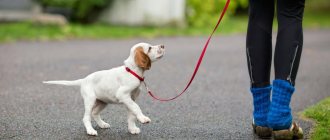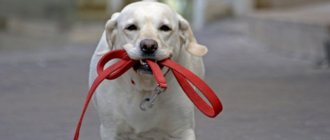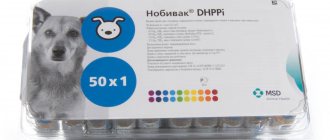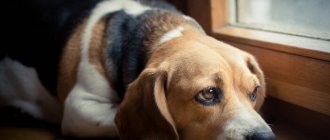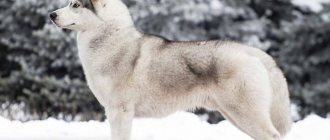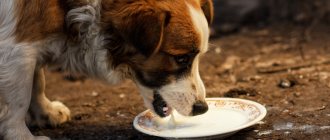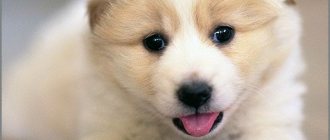Why do you need to walk your puppy outdoors?
For full development, it is important to provide a healthy dog with active movement, and the street is perfect for this. In addition, during a walk, new smells and sounds are learned, which is also an important part of development. On the street, the puppy gets to know other animals, looks attentively, remembers their habits and learns to interact with them.
Dogs need walks in the fresh air
Being in the fresh air, the dog learns the rules of behavior. In this case, all responsibility lies with the owner, because the training of commands and the future behavior of the baby depend on him.
For pets, except decorative breeds, the street is a place where they can relieve their natural needs. To this end, the owner must teach the puppy to go to the toilet outside. If this is not done, then permanent puddles at home are guaranteed.
Having found out how many months you can walk with a puppy, you need to gradually begin to accustom your pet to going outside the apartment.
Important! Frequent walks with puppies and adult dogs are a must. Huskies, terriers, spaniels, jacks, corgis and labradors especially enjoy long walks. These breeds need space, so it is better to choose parks and forests for walking.
How many times and for how long to walk
Your baby's first walks should not be long.
It’s enough to go out for 20 – 25 minutes. This time is enough for the puppy to run around and go to the toilet.
During the day, you need to take out your small pet at least 4 – 5 times. This will allow you to quickly accustom your baby to using the toilet outside the home. By six months, three walks will be enough, and by one year, two. But the time each pet spends in the fresh air is increased to one and a half to two hours.
A small puppy must be supervised and not allowed near other unfamiliar dogs.
It is unknown how an adult dog will react to a playful baby; he may scare or bite. Even a friendly large dog, while playing, can accidentally harm the baby. Over time, the pet will join the local dog community and make friends with whom it will be fun to play on walks.
The walk should not exceed one hour per day, provided the weather is warm
How long to wait before your first walk
When can you walk your puppy after the second vaccination?
Of course, any owner who is concerned about the health of their pet is interested in the question of when can they walk their puppy. The first walks should start smoothly. It is important that the dog can get used to the street and not be afraid of the surrounding vegetation and other pets.
The first walk with the puppy should be in warm weather
You also need to know at what age the puppy can be taken for its first walk. So, with strong and healthy pets, you can go for a walk at the age of one and a half months. There are two conditions for such a walk:
- the weather should be warm outside, that is, at least 10 degrees;
- The pet must be held in your arms.
In all other cases, the optimal age is 3 months, when the dog has already received a course of vaccinations. Already at this age, the puppy can walk on its own, and not in the arms of the owner.
The age at which you can walk your puppy also depends on the breed. For example, large guard breeds need to be accustomed to the street from childhood, unlike short-haired representatives. Therefore, it is necessary to organize walks at the age of one month. Decorative breeds do not tolerate bad weather, so the best solution would be to wait until they get stronger and are vaccinated.
Important! The puppy should be taken for a walk in your arms, since its bones are still weak, and it is forbidden for it to move on stairs. This is especially true for the French bulldog breed, which is vulnerable to various types of severity.
Pet owners should find out if their pet's mother is vaccinated. If she has had all her vaccinations, then by the time she gives birth she has strong immunity, which means that the puppy is protected from infection for up to 3 months. In this case, you don’t have to hold him in your arms while walking.
Decorative breeds, Yorkshire terrier, chihuahua, pug, spitz do not need constant walking. Yorkies and other decorative breeds are considered pocket dogs for this reason.
Vaccination schedule for dogs
The first vaccination is given to the puppy at the age of two months. By this time, the effect of innate immunity has weakened, and vaccination will be effective. Puppies are vaccinated against the following diseases at two months:
- Plagues;
- Parvovirus enteritis;
- Infectious hepatitis;
- Canine parainfluenza;
- Leptospirosis.
After 2-3 weeks, the puppy receives a second vaccination against the listed diseases, and also receives a first vaccination against rabies.
Then the vaccination is repeated annually. However, pay attention to the instructions. Some vaccines last longer than a year.
When and how long can you walk with your newborn in winter?
Usually it is winter that raises the most questions for young mothers. Namely, they worry that the cold is dangerous for the newborn, and that the baby may catch a cold and get sick. How can we be here? Should I wait a couple of months or go out for a breath immediately after returning from the hospital?
Let's just say that all fears are in vain if the child is dressed correctly and warmly. Moreover, in winter it is much more convenient and easier to walk with a baby, because dressing warmly is the only problem and task of parents, which, as a rule, is not difficult to solve.
Advantages of walking in winter for a newborn:
- You can go outside at any time of the day (there is no heat and stuffiness like in summer);
- It is almost impossible to overheat a child, because he can lose all excess heat through breathing (inhales cold air, exhales warm air).
- There are no insects from which the baby needs to be saved.
You may ask, at what temperature can you walk with a newborn? On the Internet you can find a huge number of options for answering this question. Everyone fantasizes as much as they like, to the extent of their thermophilic nature. They even go so far as to answer the question of when you can start walking with a newborn in the winter, but they do not recommend doing this if the thermometer shows below zero degrees and the child is under 2 months old. Naturally, this is complete absurdity.
Fresh air is important for children of any age, and especially for newborns! And no amount of ventilation can replace a full stay on the street or balcony. Western doctors have long been convinced that a child is comfortable outside in winter, even at fairly low temperatures, provided that he is warmly dressed.
To answer the question of how long you can walk with a newborn in winter, let’s turn to the official document - SanPin for preschool institutions dated May 15, 2013. According to this document, daily walks lasting 3-4 hours are recommended for children. If the air temperature is below minus 15 degrees, and the wind speed is stronger than 7 m per second, it is recommended to reduce walks (but not cancel them completely).
As a rule, for children under 4 years of age, walks are canceled if the air temperature is below minus 15 degrees, and at the same time the wind speed is stronger than 15 meters per second. And this happens very rarely.
So how long can you walk with a newborn in winter at different temperatures? Let’s collect all the information received in a table for clarity.
| Temperature and wind | Walk duration |
| Above minus 15 degrees, wind speed less than 7 m/s | 3-4 hours a day |
| Below minus 15 degrees, wind speed more than 7 m/s | 2 hours a day |
| Below minus 15 degrees, wind speed more than 15 m/s | Not carried out |
When answering the question whether it is possible to walk with a newborn in severe frost, it is worth first understanding whether this temperature for your area is truly anomalous (for example, minus 30 degrees in central Russia or the Urals), or standard, at which you will spend the next few days. 4-5 winter months (Siberia, Northern regions).
If the first option, then it is wiser not to be a hero and wait out the frost at home, ensuring comfortable conditions in the room where the child is, and regularly ventilating it.
And if you have to live at such temperatures, and they are not something out of the ordinary for you, then it is wiser to walk, at least a little and dress very warmly.
In addition, purchase in advance a special baby cream to protect your cheeks and nose from frost - it will protect delicate skin from chapping and frostbite.
Proper walking based on your pet's breed
Walk on your own site. Naturally, for owners of country houses there will be several more benefits of walking on their site. To do this, first prepare the area from any kind of “prey” that might attract the attention of our little friend. However, do not forget that you need to walk your dog not only on your property but far beyond.
The moment you walk the puppy, you can already accustom him to a leash and collar. And also on the way to achieving that our puppy does not have
worms
in the future, it should
stop picking up from the ground
I'm going.
Walking a puppy for apartment owners. For those who have a puppy living in an apartment, you will have to walk it outside. On the street, the puppy will find all kinds of “prey”, so with each attempt you need to give a strict command “fu” and look the puppy in the eyes with a stern look. To prevent the puppy from running far, it is better to lead him on a leash and collar, since our young traveler can run out of curiosity towards random passers-by.
So that in the future you can walk your puppy without a leash, you should definitely learn
command me
. This way the puppy will run up to you whenever you call.
This will help you give your puppy the freedom to roam. At first, try to choose an area where there are fewer people so you can devote time to training.
How to properly train a puppy
– you can find out by reading a separate material.
While walking, pay attention to games. To do this, buy a couple of toys for your puppy and actively use them in games. This will help your baby have fun, burn off energy and encourage his desire to play. It is in games that you can learn many commands. And new toys will attract attention when the puppy is bored at home, and he won’t have to
READ Let's keep quiet. And let's listen to life. Konstantin Skvortsov
chew things
in your apartment.
Let your puppy interact with other puppies. At an early age, choose your puppy who is similar in weight category and age. This will give the puppy the opportunity to communicate, which is important in the life of any dog. Puppies communicate with each other, play together, learn from each other. For example, if your puppy is still
shits in the apartment
, then with the help of communication he can learn to walk outside, having learned this from his friend.
Choose healthy friends for your puppy. Being around aggressive dogs can cause bad behavior in your own dog. Also, owners who do not take care of their dog may have illnesses and other unpleasant moments. To do this, choose your friend carefully.
It is important that communication is safe and that the puppies enjoy spending time together and do not harm each other.
If the puppy is still very small, then you should not walk him for too long; 1 to 2 hours will be enough. At a later age, when your puppy is toilet training, you may need to pay as many times as possible. Walking itself may not last long, but the number of times can be reached up to 4-5 times. This is explained in order to quickly accustom the puppy to the street.
It will also help you
team nearby
, to prevent the puppy from running away when you pass by a private sector with a large number of dogs or the puppy tried to run towards a random passerby.
Many leading experts insist that the first walk should take place within the immediate period after the puppy arrives in the foster family. His age matters little in this case. After all, it is so important that a walk with the new owner occurs at the moment the puppy appears in the house. If the fluffy is very tiny, this can be done by carrying him in your arms for at least half an hour.
Next, we will look at the most popular breeds of domestic dogs today and how to walk them correctly, based on the specific nature of the dog in relation to its breed:
- Husky. This breed is very susceptible to diseases of city pets, because its nature was formed and intended for completely different living conditions. Because of their “cleanliness,” huskies are a kind of tasty bait for various parasites - fleas, lice eaters, ticks, etc. Therefore, the owner needs to thoroughly prepare the little pet for the first walk, especially in the city. This breed is more resistant to viral and infectious diseases.
- Chihuahua. The first walk with a puppy of this breed should take place no earlier than the pet is 5-6 months old. Despite their apparent fragility, Chihuahuas have strong immunity and are immune to illness, adapting to any climate. Do not be mistaken when considering a walk with this miniature pet, carrying it in your arms or, especially, in a bag. This is a living and very mobile creature that also needs to warm up. Naturally, it is better for your pet to take its first steps in the fresh air away from roads and strangers, especially dogs. A clearing in a park with short grass is best.
- Dachshunds. They begin to walk pets of this breed only after a full range of necessary vaccinations. In terms of age, this is approximately 3 months. During the first walk, the dachshund will be a little stressed due to fear of the unknown, so it is better to carry out this event without letting him out of your hands for a long time. If the puppy is very active, you can let him out to run, but with a minimum number of strangers. If the dog is frightened of something, do not try to immediately grab it in your arms - pet it, calm it down in an even tone of voice, call it by name. You quickly get used to everything good - and dogs are no exception. If you carry your pet in your arms all the time, he will refuse to run on his own. Under no circumstances should you use the now popular roulette leash when walking your dachshund. Due to the physiology of this breed, this will cause some physical pathologies in the animal.
- Yorkshire Terrier. Many people choose small dogs for themselves, hoping that they don’t necessarily need to be taken out into the fresh air for a walk, and that they can crap at home, once they are trained to use a litter box. But this is absolutely false. The Yorkshire Terrier needs to be walked in the same way as other dogs. Imagine for a second that you are locked in an apartment and are not allowed out. Reclusion will be reflected in depression in the animal; it will simply “fade away”, despite the best conditions and nutrition. Not everyone knows that by its nature this breed is a hunting breed, which was specially bred in old England to catch rodents. Therefore, after the standard first vaccinations, you can safely take your pet out for a walk.
- Jack Russell Terrier. The duration and number of walks with the puppy depend entirely on its age. After quarantine, it is better to take the dog outside for short visits. In wet weather, it is better to reduce the duration of walking as much as possible, since this breed is very susceptible to respiratory diseases. It will not be superfluous to insulate your pet with a blanket. You should not completely cancel walks, this will have a bad effect on your dog’s mood.
- French Bulldog. Quarantine after the first mandatory vaccinations for a French bulldog lasts about a week. Walking is preferable after each meal in order to develop the necessary reflex and routine. Such walks should not be long, but rather become a kind of “potty” trip. It is worth understanding that during the first walks you will have to carry your pet a lot in your arms, since puppies of this breed are contraindicated from walking on steps. If the owner does not know this, over time his dog’s spine will become deformed, the size of its paws will change, and a hernia may appear.
READ Favus scab in cats
Why do puppies need quarantine for the first 2 weeks after vaccination at 3 months?
Walking dogs: how many times a day should you walk by time?
To protect the life of your pet, after a course of vaccinations, you must comply with quarantine. Animal immunity develops faster against a number of diseases, but protection against leptospirosis and rabies appears only 2 weeks after the course has been completed.
After vaccination, the dog's activity decreases for several days
After vaccination, the dog's behavior must be closely monitored. In the first three days, the dog is characterized by a decrease in activity. Babies may whine in fear. Side effects are also noted:
- refusal to eat;
- itching;
- lethargy;
- intestinal disorders;
- increase in temperature.
A veterinarian's consultation is required if your dog behaves in the following ways:
- The dog itches, chokes, the mucous membrane turns blue. All these are symptoms of anaphylactic shock.
- The temperature reaches 39 degrees, accompanied by weakness, cramps, vomiting and frustration.
Is quarantine mandatory?
Although it seems that vaccination is a fairly simple procedure, after it the dog’s body becomes weakened. During this period, your pet can contract a number of diseases that can be fatal. This is why quarantine is not only possible, but required.
In this case, it means complete isolation from society. If for an adult dog such restriction from the outside world is not necessary, then for a puppy it is vital.
Rules of conduct for 2 weeks after administration of the vaccine:
- Limit the puppy's interaction with other animals.
- Limit contact with objects that may contain viruses (outdoor shoes, etc.).
- Give up the idea of walking your pet.
- Avoid water procedures.
- Do not introduce changes to your usual diet.
- Reduce physical activity.
Important! During immunization, it is worth asking your veterinarian when the puppy can be taken outside. He will be able to determine the time period if the owner is afraid to make a decision himself, and will tell him when walking will be allowed.
What vaccinations does a puppy need to get?
The vaccination plan includes mandatory vaccinations against rabies, leptospirosis, canine distemper, enteritis and parainfluenza. In endemic areas, additional vaccinations against coronavirus enteritis and Lyme disease are possible.
Doctors follow approximately the following schedule:
- at 1.5-2 months – first vaccination (nobi-vak DHP+L);
- 10-14 days after the 1st vaccination - second vaccination (nobi-vak DHPPi+RL);
- at approximately 6-7 months (after a complete change of teeth) - the third vaccination (nobi-vak DHPPi+R+L) with the addition of a rabies vaccine;
- in 12 months after the third vaccination (or a year) - the fourth and subsequent vaccinations (nobi-vak DHPPi+R+L).
Subsequently, the adult dog is vaccinated annually.
Important! After the first vaccination, the puppy is not allowed to walk. After the second, exercise is allowed after 10-15 days. After the remaining vaccinations, you can go for walks, but reduce physical activity on your pet.
10 days before the first, third and fourth vaccinations, the puppy is given anthelmintic suspensions/tablets, for example, drontal plus (1 tablet per 10 kg of weight) or milbemax.
Lyme disease
Vaccination is carried out in certain regions, where the causative agent of borreliosis affects up to 20% of ticks . Not all dogs react to Borrelia - 10% show no visible symptoms. Others experience the disease acutely: their musculoskeletal system and internal organs are affected.
Parainfluenza
This viral infection settles in the upper respiratory tract and penetrates there through airborne droplets. As a rule, unvaccinated puppies up to 1 year old get sick, demonstrating good recovery dynamics. Mortality from parainfluenza is extremely rare.
Immunization is carried out at the age of 8 and 12 weeks using a polyvalent vaccine.
Leptospirosis
This bacterial infection (transmitted by rodents, domestic and game animals) has an increased mortality rate (up to 90%). The disease affects small vessels, causes acute intoxication and, as a result, malfunction of the most important organs.
Vaccination against leptospirosis is routine. It is given to 2-month-old puppies, including in a comprehensive vaccination. Sometimes monovaccines “Biovac-L” or “Nobivac Lepto” are used.
Carnivore plague
This viral infection has a high mortality rate, reaching 60–85%. Distemper is characterized by fever, inflammation of the mucous membranes, pneumonia, damage to the nervous system and gastrointestinal tract.
Specific prevention of the disease is vaccination. The first vaccination is given (as part of a complex one) at 2 months of age.
Rabies
The most dangerous and incurable disease with 100% mortality, which is why it requires mandatory preventive measures. For puppies, Nobivac Rabies, Defensor 3, Rabisin-R and Rabikan (strain “Shchelkovo-51”) are recommended. The vaccination is done 3-4 weeks after the first vaccination (with regular vaccination once a year).
Parvovirus enteritis
A common infection with an impressive mortality rate (up to 80%) and high contagiousness . The disease occurs in a complicated form (especially in puppies up to six months), accompanied by myocarditis, severe vomiting and severe dehydration.
The enteritis vaccine is also included in the Nobivac DHPPi complex vaccination and is given to animals at 8 weeks of age. The single vaccines Primodog, Biovac-P and Nobivac Parvo-C are used less frequently.
Return to content
Rules for walking after vaccination
German Shepherd: caring for a puppy and an adult dog
The first walk with the puppy on the street should leave him with vivid impressions, because it is important that the pet is not afraid to be outside the apartment. For a successful walk, you need to choose the right place. When going out 2 weeks after the vaccine is administered, you should organize a walk in your arms. You cannot let the puppy down to the ground.
A number of rules must also be followed:
- The day should be sunny and calm.
- You should choose a quiet place where there is no waste or other animals.
- The withdrawal time should be no more than 20 minutes.
Before going outside, you need to make sure your pet is feeling well. He should not have lethargy, drowsiness or fever.
Walk in your own area
If the owner has his own plot, fenced from prying eyes, then it will be an ideal option for organizing a walk. The Beagle dog breed will especially like this alternative.
Since puppies are quite curious, before going for a walk you should remove from the area all objects that they can eat. The same should be done with potentially dangerous items. Attention must be paid to the strength of the fence, because while on the site, the baby may want to frolic behind the fence.
Walking outside
Since the street is a public place, a number of rules must be followed:
- Put a collar and leash on the puppy.
- If the weather is cool, then wear warm overalls.
- Watch carefully so that the baby does not pick up any objects from the ground.
Active dogs need to be closely monitored when walking.
Content
The main thing in keeping a beagle is to show your pet to the veterinarian in a timely manner, provide adequate nutrition and devote a sufficient amount of time to walks and training. A dog of this breed, due to its small size, can feel comfortable both in an apartment and in a house. The peculiarities of keeping them under certain conditions are described below.
In the apartment
To make your pet feel comfortable, you need to organize a place for him. The ideal place would be the room where the owners spend most of their time, so that the beagle can watch the family members. To create a place for your pet, you need to purchase a lounger and cover it with toys so that the dog does not get bored while everyone is at work or busy. This breed is very active and needs fresh air to release energy. Loves company while walking or jogging. You should only take him outside on a leash, as your pet could chase the cat and get hit by a car.
On the street
Beagles get along well in the private sector, on the street. The best option is a large, equipped enclosure. A representative of this breed loves to dig under the ground, which means it can escape if protection from escape is not provided. The floor of the enclosure should be concrete, the bars should be metal, and there must be plenty of toys for entertainment. It is necessary to play with him and let him run around the yard for full growth and development.
Beagle in winter
Animals are smooth-haired and most of them do not need clothing in winter. The dog is always active outside and does not have time to freeze. In the 21st century, it has become fashionable to dress animals. So for this breed for the winter, models of overalls with fleece have appeared. If the pet lives in an enclosure in winter, the booth must be insulated or moved into the house. The main thing is to avoid hypothermia to avoid illness.
What should I dress my child in?
The principle of selecting clothing is based on its suitability to weather conditions. If it’s hot outside, the baby can be dressed in a bodysuit (or blouse). Very young children are usually covered with a light diaper. Accordingly, cooler weather requires that the baby wear rompers, additional blouses, a suit and a hat. More convenient are modern overalls, which replace several things at once and are convenient for quickly dressing a child. Overalls can be winter, demi-season and very light (made of thin knitwear, so-called slip overalls).
Winter overalls in combination with a sleepsuit or blouse and rompers are used at air temperatures below +5°C.
Some mothers prefer to use envelopes for walking with their children in the first weeks of life. Envelopes also come in different varieties - from a lightweight version (for example, made from fleece fabric) to a rather warm, fur one.
How to properly walk a puppy without vaccinations
Not all pet owners have had their pet vaccinated. Of course, you can walk an unvaccinated puppy, but you must carefully monitor its behavior on the street and subsequently upon arriving home.
Owners also need to know when they can start walking their puppy outside without vaccination and how to do it correctly. So, you can take him outside for no more than 1 hour. If he feels uncomfortable, then you need to return home as soon as he relieves himself.
Important! In order for the pet to develop correctly, it must be allowed to walk with other dogs.
If you limit your dog's communication, in the future he may display unreasonable aggression towards his own kind or cowardice. The social circle for a puppy without vaccinations should be chosen personally. It is best to let him walk with domestic dogs that are vaccinated. If he is not vaccinated, you can vaccinate yourself with Nobivak.
At what age can you walk a puppy?
A small puppy requires love, patience and good care from the owner. Proper care consists of creating a diet and creating protection against various infectious diseases. Such protection in the first year of an animal’s life is provided by timely vaccination.
The immune defense of a newborn puppy is poorly developed, so it is impossible to do without the most important first vaccinations. Veterinary experts strongly do not recommend taking your baby out for walks without the necessary vaccinations.
If the owner’s desire to introduce the pet to the outside world is so great, then you can walk with the puppy in your arms. It is necessary to try to isolate the puppy from contact with relatives and people. Long walks for puppies under 2 months are not recommended by experts. Breeders claim that 10-15 minutes a day for a puppy to go outside will be more than enough.
Before real walks in open space, you need to prepare the puppy in advance. Preferably in an apartment. The main thing a puppy must learn is to respond to a nickname, respond adequately to a leash, and follow the simplest but very necessary commands: “Come to me!”, “Stop!”, “You can’t!”
The puppy owner must comply with mandatory vaccination schedules. The first immunization is carried out when the puppy reaches the age of 2 months.
Until this moment, maternal immunity received during intrauterine development circulates in the puppy’s body. The first milk (colostrum), which the female feeds her offspring, also has a lot of components that help protect the body from harmful factors. After the end of the immune protection, it is recommended to carry out the first vaccination.
After vaccination, walks with the puppy are prohibited due to the risk of dangerous infection. After a few weeks (depending on the state of health and other anamnestic indicators), the puppy is given the next vaccination. Typically, the second vaccine is given at 3.5 months of age.
It is important not only to understand what vaccinations a puppy needs, but also how to prepare correctly. Proper preparation for further routine immunization allows the puppy’s body to adequately build an immune defense. The body’s reaction to the administered vaccine also depends on proper preparation.
The body of a small puppy is unusually susceptible to various infectious diseases. The likelihood that an unvaccinated puppy living in an urban environment will become infected with a dangerous infection is incredibly high. Timely immunization is an excellent way to prevent various infectious diseases that affect domestic dogs.
There are several modifications of vaccines on the pharmacological market - monocomponent (against one disease) and multicomponent (allowing the development of immune protection against several diseases at once). The selection of the drug should be carried out by a veterinarian who will first conduct a comprehensive examination of all vital organs of the puppy.
The first vaccination of a puppy is carried out to prevent infection with infectious diseases such as:
- carnivore plague;
- hepatitis of infectious origin;
- parvovirus infection;
- leptospirosis and parainfluenza.
After 14-21 days, the puppy is indicated for revaccination against the above-mentioned infectious diseases. It is also recommended to vaccinate against a dangerous disease - rabies. As a rule, it is recommended to revaccinate the dog annually in the future.
Most vaccines provide lasting immunity for 12 months, some longer. In order not to get confused about the timing of vaccinations and antiparasitic treatments, veterinarians and professional breeders recommend getting a special passport for the puppy.
Only after the first most important preventive immunization has been carried out and the quarantine has ended, you can try to accustom the puppy to walks outside.
Expert advice
What about hormonal drugs? We haven't forgotten about them, of course. However, following the advice of veterinarians, we recommend using them only in exceptional cases. It should be understood that regular use of them causes metabolic disorders in animals. And it already manifests itself in the form:
- inflammation in the organs of the reproductive system;
- problematic pregnancy;
- weak or sick offspring;
- difficult births leading to caesarean sections;
- tumors of the mammary glands and uterus, including malignant ones.
This is why responsible specialists prefer sterilization when owners don’t want to hear about furry children. The advantages of this option for solving the problem of offspring are obvious: you save yourself and your pet from suffering, prevent the dangerous consequences of using hormonal drugs and, in the end, reduce the number of useless defenseless lumps.
However, having decided to sterilize your pet, you should remember that before the operation, they usually need an examination by an experienced veterinarian, and after that - competent and caring care. You also need to find out what she should be vaccinated with. If everything is done professionally and with love, your cat will not be in a state of chaleur, warming the house with its love for many, many years.
Loading …
When to walk your adult dog after vaccination?
Adult dogs who are already one year old are vaccinated annually, and with a whole complex. A separate injection is often added to the injection, which contributes to the formation of resistance to rabies.
There is no clear schedule for vaccinating male dogs. For females, the vaccination period is selected depending on estrus and mating. In this case, it begins one month before mating begins.
A vaccinated dog, when mated, is subsequently able to give birth to healthy offspring. At birth, puppies receive strong immunity for up to 3 months without vaccinations.
After vaccination, adult dogs should be walked separately from other animals.
It is not prohibited to go for a walk with an adult dog. However, towards the end of the year of life, immunity weakens. Therefore, before and after vaccination, an adult dog should be taken out separately from other dogs for 2 weeks, without allowing heavy loads. To protect your pet, it is better to extend the quarantine period to 3 weeks, as there is a risk of contracting rabies. Plague also poses a threat.
If it’s winter outside, you shouldn’t give your pet a full bath after a walk. It is enough to wash only the paws. If there is a need to clean the fur, it is best to do this with dry shampoo.
At the end of quarantine, the dog is gradually returned to its usual rhythm of life. They remove the ban on swimming in reservoirs, especially if this happens in the summer, and communicating with other dogs. In summer, the dog is shown frequent withdrawal.
Important! The formation of swelling at the injection site is not a pathology and does not require consultation with a veterinarian.
Why is there no heat?
With good general health and the state of the reproductive and hormonal systems, the dog's first heat occurs at the established usual times and then repeats with a certain cyclical regularity. If the dog is older than 18 months, and the first heat has not come, you should consult a veterinarian to find out the reason for this delay.
The main reasons for the delay/absence of the first heat:
- poor living conditions, improper or insufficient feeding;
- disruption of hormonal regulation of the reproductive system;
- congenital disorders in the development and structure of the genital organs;
- ovarian dysfunction (hypofunction, lack of appropriate hormones during the appropriate period);
- dysfunction of the pituitary gland and/or thyroid gland;
- tumors and/or other neoplasms, cysts of the pelvic organs or directly on the ovaries;
- endocrine pathologies;
- chronic inflammatory processes in the uterus;
- hermaphroditism (for example, when underdeveloped testes are found instead of ovaries).
